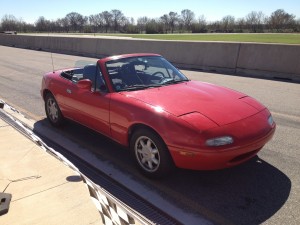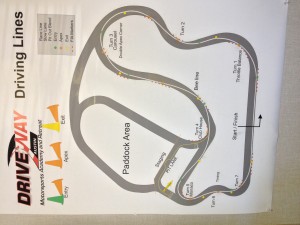Larry owns and runs the mixed martial arts gym I frequent, and drives a Mustang, which he is busy pimping out. I used to scoff at such cars – all metal and weight and straight lines – but I hear his tales and have a new found respect for the pony car. He tells of impromptu races on the highways, and come to think of it, most of them are extremely straight – maybe not Roman road straight, but very little steering is needed for a drag race.

Larry explained that he was giving a Nissan GTR a run for its money – all $98,000 of it – last weekend, and I started to warm to the idea of a relatively low tech and relatively affordable piece of iron that could see off the Japanese technofest. I found myself inching along the path to reasoning that living in the US, I should probably own another US car – they probably don’t even allow Mustangs in Europe, and the price of running them is probably akin to that to stable Red Rum.
Then it was time for my day at Driveway Austin – a course tantalizingly close to a friend’s house, and not 15 minutes from my door. The course was built in the boonies (the wrong side of East 183 being thus considered a decade ago) by an ex-Ferrari racer who wanted to put some of his favorite corners within the reach of people, I guess, like me. The L1 course – Foundations of Road Racing – was a 7 hour adventure in torturing the rubber beneath your car into submission.

I had stayed up late working on my 1990 Miata MX5 – making sure the embarrassing belt slipping was silenced, and that the battery wouldn’t fly loose on the first corner. Maybe a new PCV would stop the oil hemorrhage I reasoned. Previously I had taken Exxon Bubble Balloon Valdez (as the kids had named it) to Automotive Specialists in Round Rock – the recommendation of one of the Driveway professional racers to get the shocks replaced, and a performance alignment. This made cornering less like jumping between trampolines strapped to the back of hovercraft set off to replicate Brownian motion on a large scale, and more like driving a car around a corner. Which made me relax a whole heap more than my first Miata track day, where every corner was less a leap of faith and more a pogo of doom.
My path for the Miata then, had been: 1. learn to go around corners a bit, then 2. put a turbo on it, just because I like turbos. Which brings me back to the Mustang. A fine straight line vehicle (which can probably go around corners a little bit I imagine) which would love a turbo, some nitrous or some supercharging. And I had presumed adding forced induction to my Miata would be a good thing, but apparently not. So say the people that make cars go around corners for a living at Driveway. And I’ve come around to their way of thinking.
For me to spend $500 on shock absorbers is a first. I’ve never replaced even the most worn out shocks in any of the dozens of cars I’ve owned. I’ve wallowed around in cop cars, leaned violently in trucks and never thought to spend a dime on suspension. But it turns out that it’s very handy to have decent suspension if you want to go around corners predictably.

The young whippersnapper who instructed me today in the fine art of steering with the throttle, and in passing showed us how to do a 180 spin in a family saloon car, also mentioned after about 3 corners in my Miata that I needed new sway bars. And better wheels and tires. And I lapped up the advice, jotting down details about the Kumho Ecsta XS 205/50ZR15 tires, the Team Dynamics Motorsports Pro Race 25mm offset wheels and more.
In part, putting good looking wheels on my rusty old banger will make it look deft and nifty, and maybe detract from the gaping hole in the back window. Theoretically, it should make it go around corners better. Right now, it doesn’t seem sluggish to me in the corners. I have a Dynolicious app on my phone that captured lateral acceleration, and looking at the graph below, it’s almost 1g around the corners. Which is a lot.

So the track day and training were awesome. I could bang on about the young men who sat patiently in my passenger seat commenting on how I could turn faster, and how they got in the driver’s seat and proved how much faster my car would both go and stop. I could talk about the elation, the exhaustion. The competition I had (in my head at least) with the mum and son team in the $35k Audi. The power steering. The joy of cornering by pushing into the steering wheel and the dead pedal. The inability to use heel and toe on a down shift, or the engine’s sheer refusal to explode as it was forced around in giddying circles in second and third gears for hours.
But aside from all those things, it struck me most that auto-racing is like any project. Typically the work expands to fill the available time in most of my projects. In racing, the equipment just expands to consume the budget. After all, I might be 0.5 second a lap faster if I spend $600 on wheels, $500 on tires, and $300 on sway bars. And my car would look more badass too, which has to be worth something to a man having another mid-life crisis.
